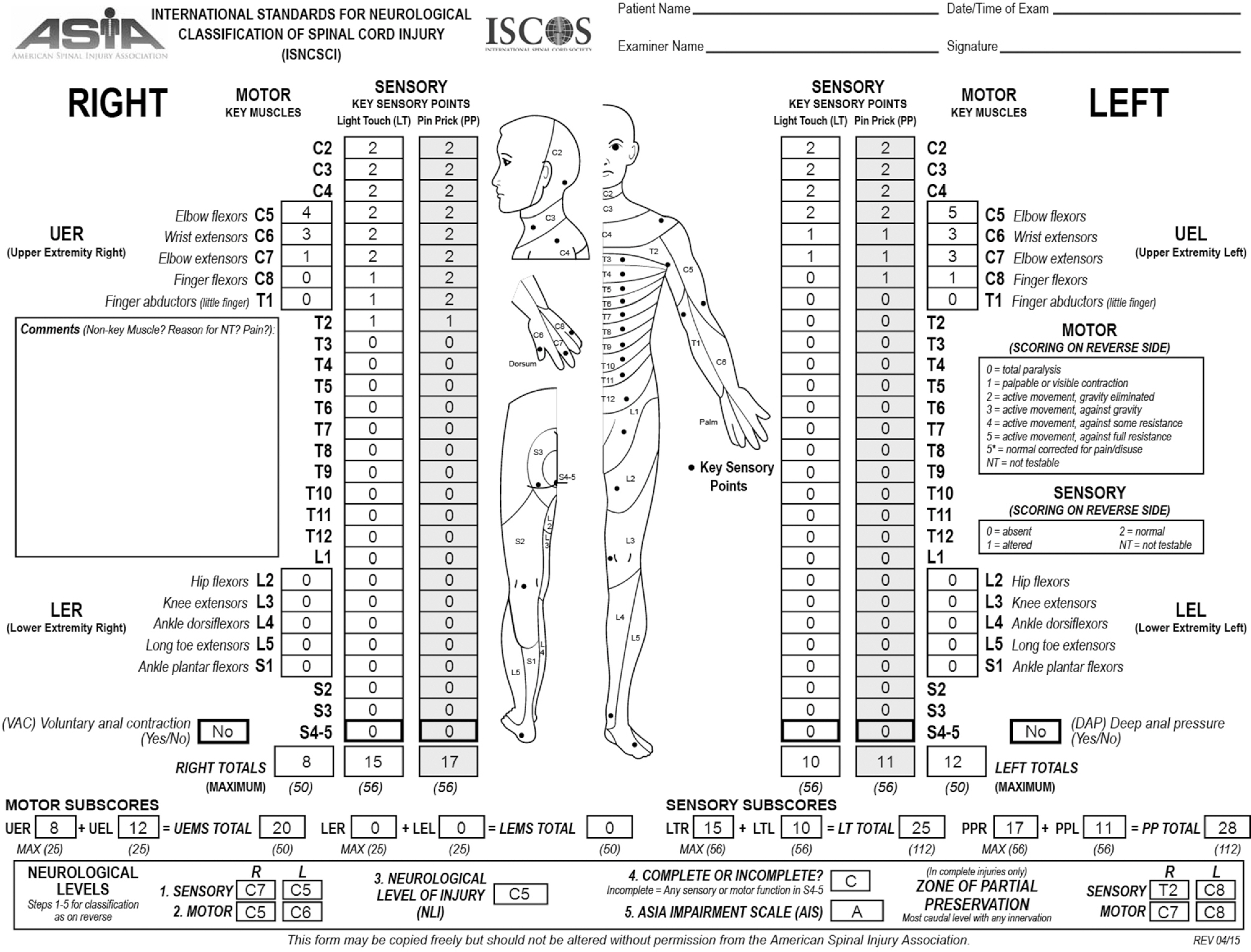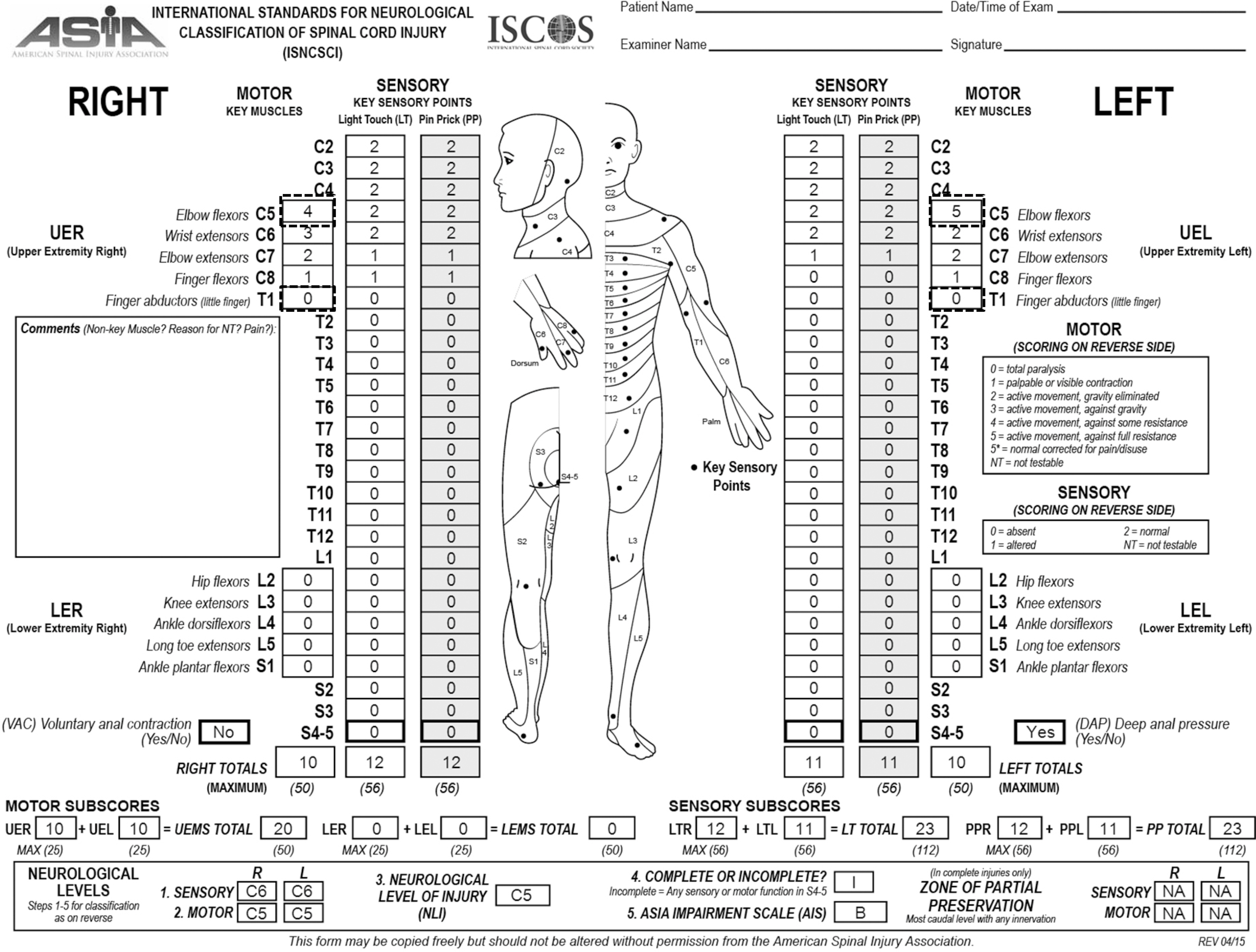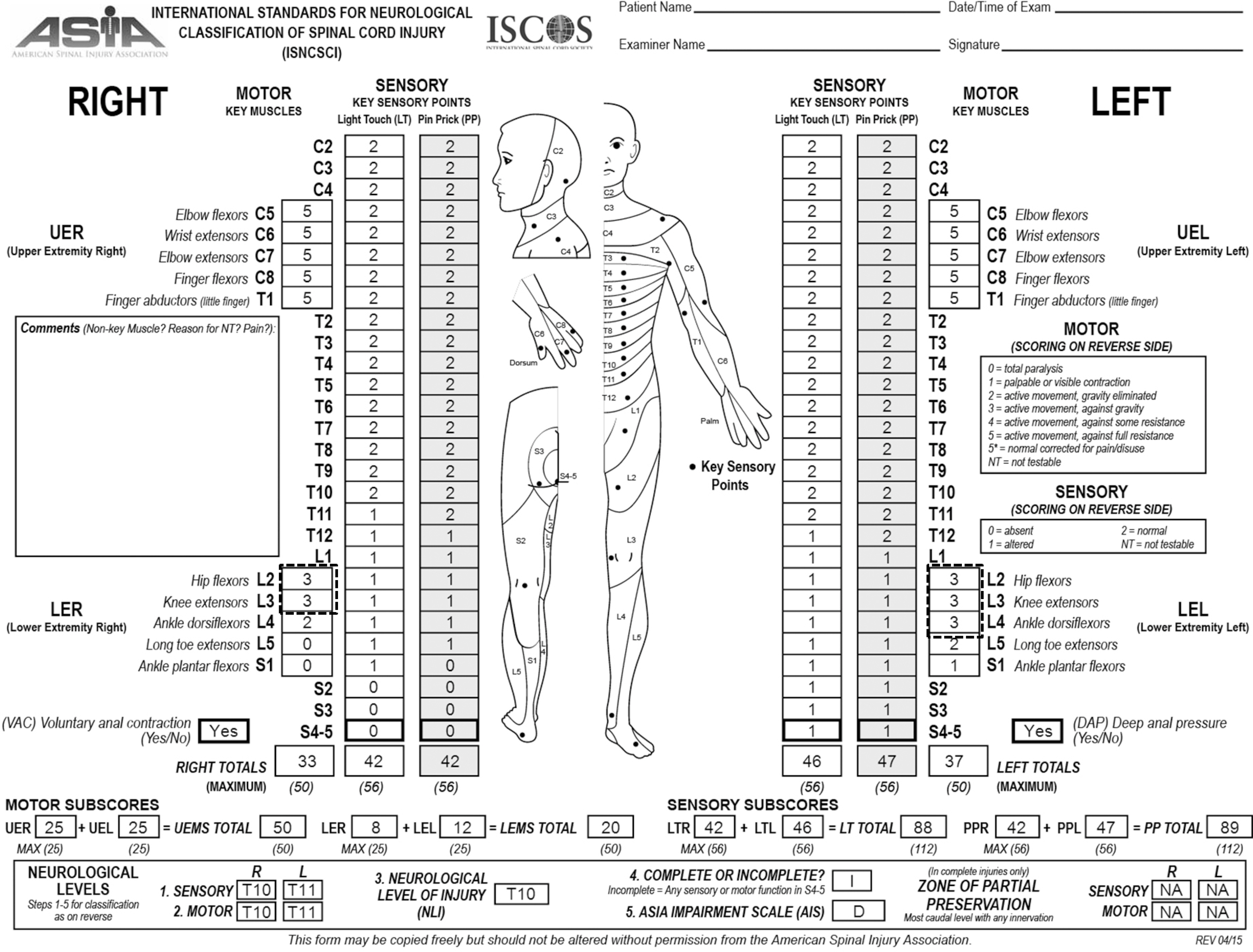J Korean Soc Spine Surg.
2018 Jun;25(2):81-89. 10.4184/jkss.2018.25.2.81.
Initial Assessment and Management of Patients with Spinal Cord Injury
- Affiliations
-
- 1Department of Orthopaedic Surgery, Jeju National University Hospital, School of Medicine, Jeju National University, Jeju, Korea. jys@jejunu.ac.kr
- 2Department of Rehabilitation Medicine, Inje University College of Medicine, Korea.
- KMID: 2421615
- DOI: http://doi.org/10.4184/jkss.2018.25.2.81
Abstract
- STUDY DESIGN: Literature review.
OBJECTIVES
To summarize the most up-to-date information on the initial management and neurological examination of patients with spinal cord injury (SCI). SUMMARY OF LITERATURE REVIEW: Secondary injuries result from acute pathophysiological processes such as bleeding, hypoperfusion, inflammation, necrosis, and apoptosis around neural elements that initially survive a mechanical injury.
MATERIALS AND METHODS
Orthopedic surgeons must be familiar with the anatomy of the spinal cord and the initial management of a patient with SCI. A detailed neurological examination in accordance with the International Standards for the Neurological Classification of Spinal Cord Injury is a prerequisite. It is important to distinguish between spinal shock and neurogenic shock, which are characteristic phenomena in patients with SCI.
RESULTS
Rapid realignment of the spine and proper medical management to avoid hypoperfusion are important in the overall care of a patient with SCI.
CONCLUSIONS
Patients with SCI should be managed and treated properly to enable them to return home and to their work as soon as possible.
Keyword
MeSH Terms
Figure
Reference
-
1. Barson AJ, Sands J. Regional and segmental characteristics of the human adult spinal cord. J Anat. 1977 Jul; 123(Pt 3):797–803.2. Barson AJ. The vertebral level of termination of the spinal cord during normal and abnormal development. J Anat. 1970 May; 106(Pt 3):489–97.3. Azar FM, Beaty JH, Canale ST. Campbell's Operative Orthopaedics. 13th ed.Philadelphia: Elsevier;2017. 1572-7.4. Di Chiro G, Fried LC, Doppman JL. Experimental spinal cord angiography. Br J Radiol. 1970 Jan; 43(505):19–30. DOI: 10.1259/0007-1285-43-505-19.
Article5. Milen MT, Bloom DA, Culligan J, et al. Albert Adamkiewicz (1850-1921)–his artery and its significance for the retroperitoneal surgeon. World J Urol. 1999 Jun; 17(3):16870. DOI: DOI:10.1007/s003450050126.6. Dommisse GF. The blood supply of the spinal cord. A critical vascular zone in spinal surgery. J Bone Joint Surg Br. 1974 May; 56(2):225–35. DOI: DOI:10.1302/0301-620x.56b2.225.7. Levi AD, Hurlbert RJ, Anderson P, et al. Neurologic deterioration secondary to unrecognized spinal instability following trauma–a multicenter study. Spine (Phila Pa 1976). 2006 Feb 15; 31(4):451–8. DOI: 10.1097/01. brs.0000199927.78531.b5.
Article8. Azar FM, Beaty JH, Canale ST. Campbell's Operative Orthopaedics. 13th ed.Philadelphia: Elsevier;2017. 1756-69.9. Harris MB, Sethi RK. The initial assessment and management of the multiple-trauma patient with an associated spine injury. Spine (Phila Pa 1976). 2006 May; 31(11 Suppl):9–15. DOI: 10.1097/01.brs.0000217924.56853.0d.
Article10. Stiell IG, Clement CM, McKnight RD, et al. The Canadian C-spine rule versus the NEXUS low-risk criteria in patients with trauma. N Engl J Med. 2003 Dec; 349(26):2510–8. DOI: DOI:10.1302/0301-620x.56b2.225.: 10.1056/NEJ-Moa031375.
Article11. Daffner RH, Sciulli RL, Rodriguez A, et al. Imaging for evaluation of suspected cervical spine trauma: a 2-year analysis. Injury. 2006 Jul; 37(7):652–8. DOI: DOI:10.1302/0301-620x.56b2.225.: 10.1016/j.injury.2006.01.018.
Article12. Available from: http://asia-spinalinjury.org/wp-content/uploads/2016/02/International_Stds_Diagram_Worksheet.pdf.13. Available from: http://www.isncscialgorithm.com.14. Delamarter RB, Coyle J. Acute management of spinal cord injury. J Am Acad Orthop Surg. 1999 May-Jun; 7(3):166–75.
Article15. Ditunno JF, Little JW, Tessler A, et al. Spinal shock revisited: a four-phase model. Spinal Cord. 2004 Jul; 42(7):38395. DOI: DOI:10.1302/0301-620x.56b2.225.: 10.1038/sj.sc.3101603.
Article16. Nankovic V, Snur I, Nankovic S, et al. [Spinal shock. Diagnosis and therapy. Problems and dilemmas]. Lijec Vjesn. 1995 Jun; 117(2 Suppl):30–2.17. Kwon BK, Tetzlaff W, Grauer JN, et al. Pathophysiology and pharmacologic treatment of acute spinal cord injury. Spine J. 2004 Jul-Aug; 4(4):451–64. DOI: 10.1016/j.spinee.2003.07.007.
Article18. Silva NA, Sousa N, Reis RL, et al. From basics to clinical: a comprehensive review on spinal cord injury. Prog Neurobiol. 2014 Mar; 114:25–57. DOI: 10.1016/j.pneurobio.2013.11.002.
Article19. Kakulas BA. The applied neuropathology of human spinal cord injury. Spinal Cord. 1999 Feb; 37(2):79–88. DOI: DOI:10.1038/sj.sc.3100807.
Article20. Ramer LM, Ramer MS, Bradbury EJ. Restoring function after spinal cord injury: towards clinical translation of experimental strategies. Lancet Neurol. 2014 Dec; 13(12):124156. DOI: 10.1016/S1474-4422 (14)70144-9.
Article21. Hadley MN, Walters BC, Grabb PA, et al. Pharmacological therapy after acute cervical spinal cord injury. Neurosurgery. 2002 Mar; 50(3 Suppl):63–72. DOI: 10.1097/00006123-200203001-00013.
Article22. Morse SD. Acute central cervical spinal cord syndrome. Ann Emerg Med. 1982 Aug; 11(8):436–9. DOI: DOI:10.1016/S0196-0644 (82)80042-5.
Article
- Full Text Links
- Actions
-
Cited
- CITED
-
- Close
- Share
- Similar articles
-
- Failure of initial neurologic assessment for SCIWORA with brain injury in 22-month-old patient
- Spinal Cord Injury Rehabilitation (II): Management of Neurogenic Bladder
- Management of Spinal Cord Injury Pain with Small Divided Doses of Intravenous Ketamine
- Subacute Progressive Ascending Myelopathy: A case report
- Nerve injury in an undiagnosed adult tethered cord syndrome patients following spinal anesthesia: A case report





